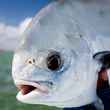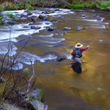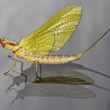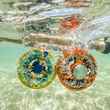The dejected slump in my shoulders must have been palpable. We'd pushed into a skinny maze of mangroves in search of big Mayan bonefish along the Mexican border with Belize, and we found them. But I was sure I’d blown my chance to bring a nice fish to hand.
Adrielle, my guide for the day, spotted two big fish – maybe 5 pounds each (bigger than average in this corner of the world) – lurking along the cover line, just as I pointed my rod at the deliberately moving bones.
"Yes!" he said enthusiastically in my ear. "That's them. Cast!"
I'd been at it for a week by the time I encountered these fish, and the best practice for achieving flats fishing competence is … well … flats fishing. I did a quick backcast and launched the rubber-legged Gotcha toward the line of mangroves.
The cast was good. Too good. It plopped down in front of the cruising fish and startled them. They scattered. I was crushed.
More Like This
"Cast again!" Adrielle exclaimed, pointing to one of the retreating bonefish. Rather than argue, I lifted the line recast well ahead of the fleeing fish.
"Good," Adrielle said. "Now, wait."
The bonefish, still in retreat mode, approached the fly as it lay in wait in the salty mud of Chetumal Bay. As it got closer, Adrielle tapped my shoulder.
"Strip."
I gave the line a half-hearted tug, and came tight to the fish.
"Never give up," Adrielle said. "They have to eat."
I'm not saying this chain of events is a common occurrence on the flats. It's not. But, in a decade spent chasing bonefish all around the Caribbean, much to the dismay of my bank account, I've learned a few things. First, Adrielle is right–they have to eat. Second, a startled bonefish isn't the same as a bonefish that's been totally spooked. A great cast might give them a fright, but they're quick to regroup. And, as we proved on the Yucatan flats, they'll eat a fly, even when they're a bit frazzled.
Also, if there is a flats fish that you can occasionally beat into submission, it's a bonefish. So long as you manage your profile and don't repeatedly line the fish, the recovery time from "no way in hell am I eating that" to "hey, that looks pretty good" can be remarkably short. A good flats guide will back the boat off a bit when the fish get tight-lipped, and he or she will instruct you to hold off, too.
When things settle down, and the fish kind of get back into their preferred routine, you can retry a cast that maybe you botched the first time. Often, if your cast is reasonably solid, you can turn a "no" into a "well … maybe." And sometimes, that's good enough.
It's even easier to get bones back into food mode if you're wading on foot. With a lower profile, you don't have to back out as far–sometimes, all it takes is kneeling a bit and being extra careful to keep from making unnecessary noise or moving too much water.
Some years back, while wading a Bahamian flat with my fishing buddy Mike, we came across a nice school of bones that had kind of tucked themselves into a little lagoon. For a couple of hours, Mike and I traded shots at leading the cruising fish and we caught several nice bonefish each. We'd positioned ourselves at the outlet of the little lagoon, and when the school tried to move on, our mere presence provided just enough of a scare to push them back inside. Then, one of us would slowly follow them, make a cast or two, and back out to unhook yet another bone that, even though it was a bit flustered, decided to eat anyway.
"It's almost like they offered up a sacrifice every few minutes," Mike said to me as we waded back to the boat for the ride back to the lodge after a day on the flats.
I nodded. We quite literally beat those bonefish into submission.
We hear from bonefishing aficionados all the time about how challenging the fish can be, and how it takes precision and patience to perfect the art of fly fishing for bones. And, quite often, all of that is true. But, frequently, it's just not. Often, bones will offer that priceless second chance … that angling mulligan.
Because, as Adrielle noted, you can't catch them if you're not casting. Never give up. They have to eat. Eventually.






























Comments
Mike Brennan replied on Permalink
Just got back from Broad Shad Cay on Andros, fishing with Andy Smith, His motto is, “keep casting until they reach the horizon.” Great point re “startled” vs. spooked or panicked. Additionally, there are times when a fish startled by a too-close cast will circle back to see what it was that scared it - and eat, maybe just to get even.
Pages